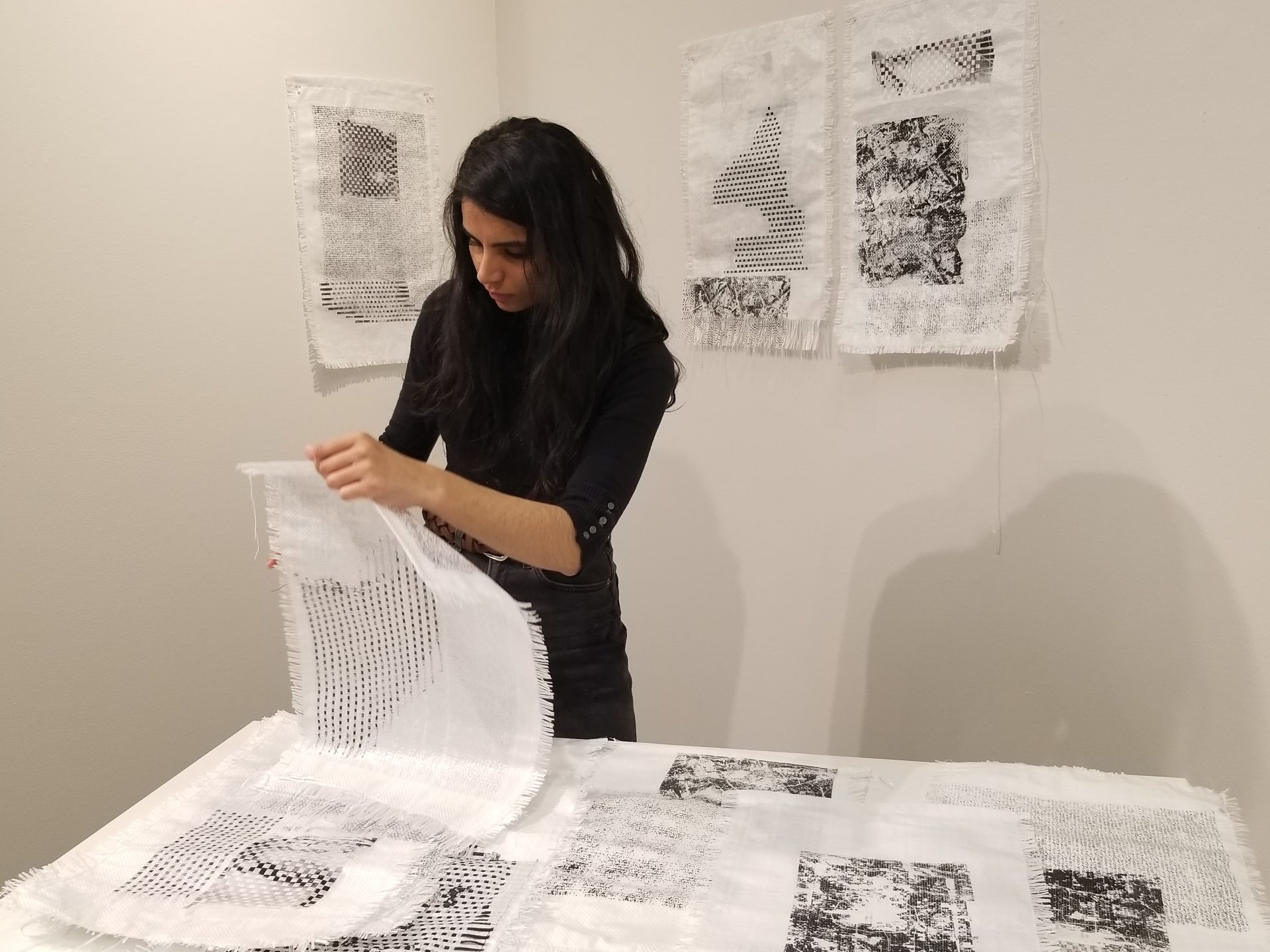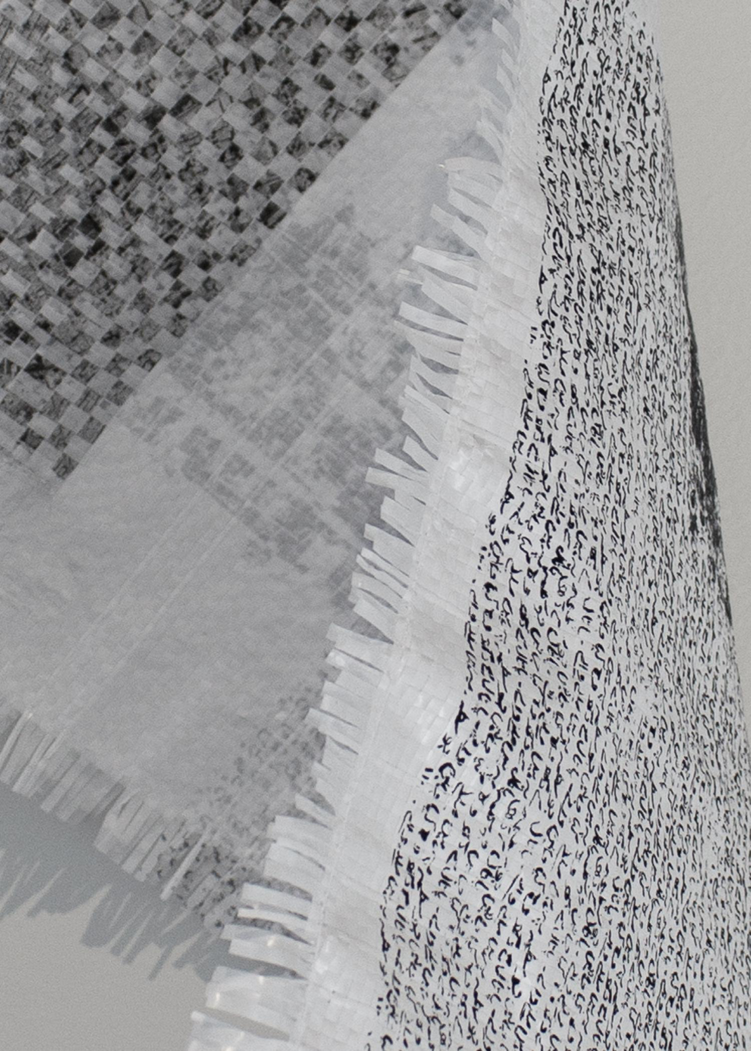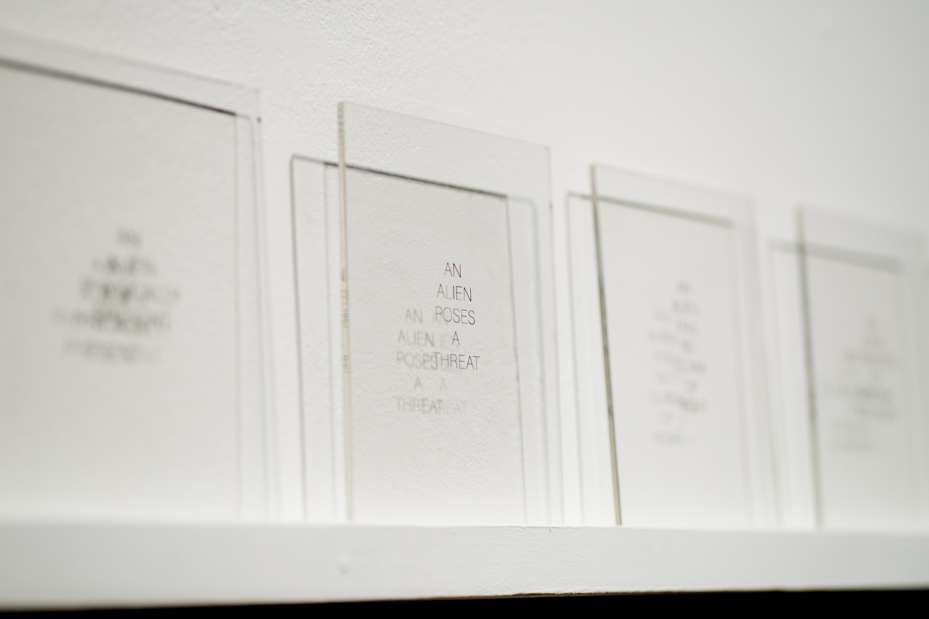
Interview with Sobia Ahmad
VisArts Next Generation/ Sanctuary Studio Fellowship 2019
August 29, 2019
By Iona Nave Griesmann
Weaving Google Maps screenshots and images of her childhood home in Pakistan with the various U.S. locations she finds herself in now, Ahmad creates intricate anti-flags that reference ambiguity of place and nationality. Doing so, she envisions ‘home’ for someone who is uprooted as a mythical place, one that is geographically unattainable and ever-shifting due to larger socio-political climates.
About the Next Generation/Sanctuary Studio Fellowship: The Next Generation/Sanctuary Studio Fellowship provides support for a promising contemporary visual artist who is emerging and/or a recently relocated refugee or asylee. The fellowship includes mentorship, a studio residency of one year, a solo exhibition, opportunities to share and exchange with the public through teaching, workshops, open studio visits, artist talks, and a community of artist peers. The mentor will assist the Fellow with the development of creative and professional goals, access to resources and services, navigation of local artists opportunities for the exposure of the fellow’s work, and exchange of ideas. Currently Fellows are selected through nomination and invitation only.
What exhibition are you working on for VisArts?
I have a solo show coming up at the end of October, that opens in November. I am working on an installation around the themes of memory, home, place and geography. I’m exploring how the idea of home for me, my ancestors and much of the world today is laced with borders and nationalism. I’ve been experimenting with weaving various materials during my fellowship here at VisArts. I’m creating flags using rice bags, but I call them anti-flags because I’m re imagining the symbol of a flag as a projection of personal, rather than national identity. I’m weaving google screenshots into the rice bags, and maps of various places including images of my childhood home, the border of India and Pakistan and maps of where I have lived, and where I live now. As I weave the maps become pixelated and unrecognizable, just like the idea of home being so vague and ambiguous for someone uprooted from a place.
Where did you learn how to weave?
I don’t know how to weave, but I am teaching myself. Weaving and rice bags are important to the work, because I’m paying homage to my ancestral history of rice farming and rituals. I arrived at the technique and material after I had a dream about my grandfather’s rice fields in Pakistan. My grandmother used to weave many things – from veils to charpai beds. I’m thinking of weaving as a way to create a metaphorical home for myself by entering a place of meditation and ritual, connecting with and preserving ancestral knowledge. I’m sewing the flags with my grandmother. Together we are reminiscing about homes we have left behind – She in India and I in Pakistan. I’m recording all the stories she is telling me as we sew, and the audio will be part of the exhibition.

Anti-flag (Detail), Sobia Ahmad, 2019, Weaving, screen print on rice bags.
Much of your work contains themes of social justice and activism. Was there a turning point when you decided to center your work around these themes, or has your work always been this way?
I’ve always explored social issues but maybe not so overtly. Even when I was in undergrad I knew that I wanted to make work about understanding my own identity, and how that sat within the larger sociopolitical climates. I think most of my work has been centered around exploring how our identities are created and affected by larger power structures, though I don’t think that’s the entirety of my practice.
When you are exploring ideas for your work, where do you usually start? Do you have a particular research process?
It’s a little bit of everything. Most of my work starts with a feeling, something that’s very personal. As I’m working through that I research about materials, history of a certain topic and other artists who are exploring similar themes. I also ask people I trust for feedback when I make something. The feeling often ends up taking the form of a question. When I was making Small Identities, the tiles with the ID photos on them, I was really interested in the question of, “How does home and architecture translate into the current political climate and rhetoric? How can I reinsert these immigrant Muslims back into the visual language in American homes today?” The arabesque tiles I’m using are a really popular motif in American homes, used in kitchens and bathrooms.
I see them in people’s homes all the time and it reminded me of my childhood. I grew up seeing these shapes, and yet to see this in people’s homes around here, and not feel fully at home was something I really wanted to tease out through the work. That’s what drew me to the tiles.
When audiences view your art, what questions do you hope they will ask?
As I’m working through a lot of these themes, and learning that when I make work which is deeply personal, it can be very universal. People can relate to the intimate struggles in a very profound way. I’m just hoping I can draw the connections between the personal, political, historical and cultural lines. For example the language I’m using from the supreme court travel ban. I’m extracting that language, the word “alien” for example, and rearranging it in a way to strip it of the specificity of the travel ban, drawing connections with the history of the United States, how the U.S. has a long standing history of violence and exclusion, and how these words taken out of the document, are actually pointing towards a larger truth about our society and history.
It’s really just about drawing parallels with the present and the past, and how
what people are going through right now may seem like this is new, but really, structurally, it’s all connected.
You mention in your artist statement that you are very detail oriented, and your work in the studio is also very minimal and meticulous. Where did this process or style originate for you?
In my practice I am really concerned with not over-decorating work or the ideas, and just using the materials that convey the message clearly and strongly. So I’m drawn to mostly minimalist styles because of how they can clearly and subtly convey the themes I’m working in. What I’m really thinking about is, “How can I say the most with the least amount of things?” My work is monochromatic because I’m thinking about how I can make use of the black, white, and gray conceptually.
Does your use of black, gray and white also tie into your messages of social structure, and the divisiveness of the current political climate?
As a spiritual practice for myself I’m trying to live more in the gray area, and not talk about or think in extremes. It’s not always easy, but drawing parallels with how often our identities are politicized and stripped down to these black and white narratives- something I experience a lot personally, is why my work is so politically and socially engaged. We are all complex beings. All of us have complex histories, ancestors, stories and personal narratives. It’s not black and white. Your life isn’t black and white and mine isn’t either. But identities tend to be politicized and talked about in that way. So, I’m really interested in how I can make use of the monochromatic scale in a way to talk about the complexity of these issues.
In your artist statement you talk about feelings of alienation and a state of not belonging. When you have those feelings, where do you find the inspiration to keep moving forward with your art?
I think all artists have that moment of feeling stuck, and it’s a constant battle of having to push through a lot of those feelings. I think making the work itself creates a sanctuary of belonging in that gray space I talked about earlier. My understanding of belonging is changing as I’m making the work; I’m growing in my own practice and in my own spiritual journey. I don’t think belonging is about nationality or place. I think of belonging mostly in the metaphysical or spiritual realm. Belonging within oneself and creating meaning as you go. Everything changes, and what you thought you belonged to also changes. While I’m really drawn to notions of place and home, these are still imagined recollections I’m working with that I’m incorporating into my current understandings of belonging.
What keeps me going through the doubts and feelings of not belonging is the possibility of miraculously ending up at another feeling that feels like belonging in a different way. Transcending these limited understandings of belonging.
There’s also a really strong and powerful outcome of just creating work rooted in your personal narrative, but also about community and what is beyond yourself. Creating this work is really showing me how even when we feel like we don’t belong personally, collectively, everyone is seeking belonging. My work Small Identities has really brought me closer to this understanding of individual belonging and communal belonging. It’s a really intimate and interesting dance that happens between the two.

Remove and Dissolve, 2018, Sobia Ahmad, engraved acrylic, ink water, cloth, 33 pieces, 3.5 x 5 inches each (standard passport size)
Before we wrap up, how do you see your art existing in the future?
The work I’m making now is relevant to the current moment, which is very fraught.
But I think much of contemporary art is speaking to a larger truth about where we have come from, and where we are headed if we are not careful. I’m realizing that even when you’re responding to the specific moment you are working in, the work shows you that it has a life of its own past that moment. I hope that the work sparks dialogue and thoughts in others about interconnection of the current moment and history, offering healing to others who are navigating similar issues as I am.
Thank you for taking your time to discuss your work!
Thank you for coming and showing interest in what I do.
To see more of Sobia’s Work visit: https://www.sobiaahmad.com/
This interview was conducted by Iona Nave Griesmann, a VisArts Intern. They specialize in illustration and are majoring in Graphic Design and Illustration at Montgomery College.
